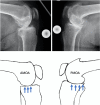Less soft tissue release in total knee arthroplasty for anteromedial compared to posteromedial knee osteoarthritis
- PMID: 35037995
- PMCID: PMC9886609
- DOI: 10.1007/s00402-021-04260-w
Less soft tissue release in total knee arthroplasty for anteromedial compared to posteromedial knee osteoarthritis
Abstract
In total knee arthroplasty (TKA), the aim of achieving a mechanically straight leg axis as well as symmetrical and equally wide gaps has become established as the gold standard in terms of surgical technique. In contrast to TKA unicompartmental knee arthroplasty (UKA) is performed in anteromedial osteoarthritis (AMOA) and does not normally require releases. This raises the hypothesis whether the type of osteoarthritis (AMOA vs. posteromedial osteoarthritis (PMOA)) determines the requirement for soft tissue releases in TKA.In this retrospective study, 114 patients with medial osteoarthritis of the knee who had been treated with a navigated total knee replacement were consecutively included. On the basis of the preoperative lateral radiographs, the patients were divided into two groups: AMOA and PMOA. The incidence and the extent of releases performed were recorded using the navigation records.Patient-specific data (gender, age) did not differ between the groups (NS). Knees with AMOA presented an overall varus alignment of 5.3 ± 3.5°, knees with PMOA 8.0 ± 4.0° (p < 0.001). 30 cases (44%) had to be released in the AMOA group, compared with 33 cases (72%) in the PMOA group (p = 0.004). In the case of medial release, the extension gap increased 3.3 ± 2.4 mm in the AMOA compared to 5.3 ± 3.7 mm in the PMOA group (p = 0.006). The medial flexion gap was released 2.2 ± 2.6 mm in the AMOA and 2.9 ± 3.0 mm in the PMOA group (p = 0.008).To achieve a neutral mechanical alignment, a release has to be performed due to asymmetry of the extension gap more often if PMOA is present than in AMOA. Surgeons should be prepared to perform more frequent and extensive medial releases in PMOA. Higher constrained implants should be available in case of unintended over release in PMOA.
Keywords: Anteromedial osteoarthritis; Extension gap; Posteromedial osteoarthritis; Soft tissue release; Total knee arthroplasty.
© 2022. The Author(s).
Conflict of interest statement
The authors declare that they have no conflict of interest.
Figures

Similar articles
-
Kinematic alignment is bone and soft tissue preserving compared to mechanical alignment in total knee arthroplasty.Knee. 2019 Mar;26(2):466-476. doi: 10.1016/j.knee.2019.01.002. Epub 2019 Feb 14. Knee. 2019. PMID: 30772187
-
Effect of Medial Soft Tissue Releases During Posterior-Stabilized Total Knee Arthroplasty on Contact Kinematics and Patient-Reported Outcomes.J Arthroplasty. 2019 Jun;34(6):1110-1115. doi: 10.1016/j.arth.2019.02.026. Epub 2019 Feb 20. J Arthroplasty. 2019. PMID: 30917888
-
Comparison of Intraoperative Soft Tissue Balance Between Cruciate-Retaining and Posterior-Stabilized Total Knee Arthroplasty Performed by a Newly Developed Medial Preserving Gap Technique.J Arthroplasty. 2018 Mar;33(3):729-734. doi: 10.1016/j.arth.2017.09.070. Epub 2017 Oct 12. J Arthroplasty. 2018. PMID: 29103777
-
Patterns of Compartment Involvement in End-stage Knee Osteoarthritis in a Chinese Orthopedic Center: Implications for Implant Choice.Orthop Surg. 2018 Aug;10(3):227-234. doi: 10.1111/os.12395. Orthop Surg. 2018. PMID: 30152607 Free PMC article. Review.
-
A flat all-polyethylene tibial component in medial unicompartmental knee arthroplasty: a long-term study.Knee. 2014;21 Suppl 1:S20-5. doi: 10.1016/S0968-0160(14)50005-1. Knee. 2014. PMID: 25382363 Review.
References
MeSH terms
LinkOut - more resources
Full Text Sources
Medical
Miscellaneous

